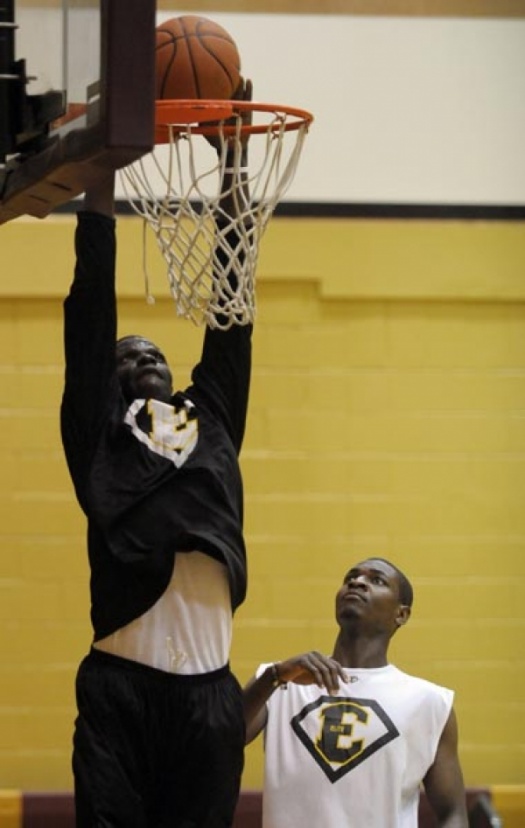
MARIETTA, Ga. – Growing up in Nigeria, Robert Ojeah fretted over the demands of everyday life, the sort of things that shouldn’t be a burden to a child.
MARIETTA, Ga. – Growing up in Nigeria, Robert Ojeah fretted over the demands of everyday life, the sort of things that shouldn’t be a burden to a child.
Would he have a roof over his head that night? What was he going to do for money? Where was his next meal coming from? He bounced around from relative to relative in search of a bed. He worked odd jobs for a few extra pennies, from construction to collecting fares on a bus. He came up with ingenious ways to get a little food in his belly.
“We would catch animals. Cook them, roast them, eat them,” he said. “Rabbits. Snakes. Squirrels.”
No matter what life dealt him, Ojeah kept growing. And growing. And growing. One day, someone suggested he might give basketball a try.
Now it’s his best hope for a better life.
“This is my big dream,” said Ojeah, who towers over most people (he’s 6-foot-10) and has muscles upon muscles on a hard-as-a-rock, 220-pound body that is all of 16 years old. “My favorite player in the NBA is Ben Wallace. I like the way he goes up to get rebounds. That is my type of game. I love to get rebounds, and I love playing defense.”
Meet basketball’s new wave.
At the top is Tanzania’s Hasheem Thabeet, a 7-2 center who played at the University of Connecticut and is expected to be one of the top picks in Thursday’s NBA draft.
He and Ojeah are part of a vanguard of African youngsters who have found their way, through hoops, from a continent mired in poverty to America – landing on the rosters of high school, AAU and college teams across the land.
Some were lucky enough to be exposed to an increasingly global game on satellite TV in their native countries. Most were keenly aware of the path laid out by pioneers such as Hakeem Olajuwon and Dikembe Mutombo, the earliest of their continent’s basketball exports.
“We’re all very pleased with the results we have seen, with how many kids are coming from Africa,” said Mutombo, whose long NBA career finally ended last month at age 42 when he injured his knee in a playoff game with the Houston Rockets. “They come to get a good education, maybe play at the professional level, or go back and get a nice job back home.”
The sacrifices are immense: They are little more than children when they leave behind family and friends, landing in a new country, a new culture. There’s loneliness. There’s alienation. There’s fear.
But as difficult as the journey is, the rewards can be even greater. They inspire many to try.
“When you go back to Africa with a degree from an American school,” Mutombo said, “you are somebody.”
At the highest level, the numbers are still minuscule: seven native Africans (including Chicago’s Luol Deng, who left Sudan to escape a civil war and considers himself British) were in the NBA this season, making up less than 2 percent of the league’s total players.
Look further though. A count from The Associated Press culled from school and basketball Web sites found more than 170 African players at U.S. colleges, junior colleges and universities last season. Other sources show 100 players or so at the high school level, many placed at prep schools catering to international students.
Not all will make it to the NBA, of course, but the growing numbers will surely have a trickle-up effect.
“There’s a lot of potential over there,” said DJ Mbenga, a native of the Congo who won an NBA championship ring last week as an end-of-the-bench backup for the Los Angeles Lakers. “If I can do it, they can do it, too.”
Mbenga, a 7-foot center, had a relatively affluent childhood in the Congo, where his father worked in the government and could afford such luxuries as vacations to Europe. But when a new regime took control of the war-torn country, Mbenga’s dad died under mysterious circumstances. His teenage son escaped a similar fate by fleeing to Belgium, which granted him political asylum.
______
To read the rest of this article, subscribe to our digital or paper edition. For previous editions, contact us for details.
AP Photo/Sara D. Davis
Copyright 2009 Associated Press. All rights reserved. This material may not be published, broadcast, rewritten, or redistributed.